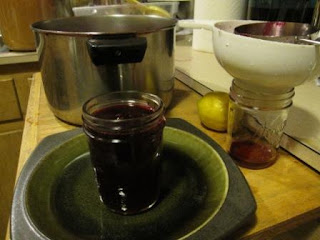This sparked an interest in gardening in Arizona, which is surely a challenge. The challenge played around in my brain for a few days until suddenly, from some dim recess, came the memory of a YouTube video I'd seen on making your own Earthbox-type planter. Well, what a perfect application for this kind of technology!
The concept is brilliantly simple. You have a planter that is divided. The bottom is a water reservoir and it is separated from the top, where the soil-less growing medium lives, by an "aeration screen". Connecting the two areas is a wicking tube, which is perforated and contains potting mix that serves to wick the water up into your top planting area. There is also a fill tube, so you can add more water to the bottom without pouring it through your growing medium. Keeps things tidy.
(If you want more info on what an Earthbox-type planter is and does, and more ideas on how to make your own, do a search on "homemade earthbox", or something similar.)
Using just a few things, most of which were already around the house, I made a small sub-irrigated planter (SIP) today. Pretty easy, in spite of it being bitter cold and spitting snow today!
Sub-irrigated Planter
Ingredients:
- plastic storage box with lid
 |
| Basic parts of the SIP |
- 3/4" tubing, about 14" for mine
- 2 zip ties
- box cutter
- tape measure
- Sharpie
- drill with 1/4" or 3/8" bit
- tin snips (helpful but not mandatory)
- peat-based potting mix (not potting soil)
- basic granulated fertilizer
- dolomite
- plants
Steps:
 Wicking tubes and aeration screen supports (yogurt containers)
Wicking tubes and aeration screen supports (yogurt containers)1. Decide how deep your water reservoir will be, which will depend on your container size and water needs. For this one, 2 1/2" was fine, which meant, surprise!, I could just cut my yogurt containers in half so there was no waste!
Using a tape measure and Sharpie, I drew a line around the containers and, using a box cutter, carefully cut each in half. The bottom halves will be wicking tubes and the top halves will be supports.

 |
| Supports & wicking tubes in place |
Aeration screen (lid of planter)
3. Measure the inside dimensions of the box at the top of the wicking tubes/supports. Mark this on your lid. For this one, the measurements coincided with the edge of the nifty raised thing in the middle of the lid! Carefully cut this out of the center of the lid with the box cutter, leaving the outer edge intact, as well as the center.
 |
| Tin snips, box cutter and gutted lid |
My lid had some fins on the inside (for extra strength, I'm sure) that were difficult for the box cutter to get through. The tin snips made short work of them, however!
4. Mark where the wicking tubes will be on your soon-to-be aeration screen. Use the base of the yogurt container to draw a rough circle for each. Now find some round and somewhat smaller item and trace a smaller circle inside the first circle.
 |
| Aeration screen w/ wicking tube holes |
5. Drill holes all over your aeration screen, except inside the wicking tube circles. Cut out the smaller circles.
 |
| Fill tube tubing |
6. Measure the full depth of your box and add a couple of inches. Cut your tubing that size.
7. Your fill tube needs to run below your aeration screen, so cut a notch in a corner of your aeration screen big enough to accommodate the fill tube.
 |
| Fill tube cinched in place & wicking tubes filled with potting mix |
9. If you desire, cut a notch in the lid edge to fit around the fill tube. You can use this lid edge to hold plastic sheeting in place as a mulch. Or just to give the whole thing a more finished look.
Assemble the whole deal
Center the wicking tubes under their holes in the aeration screen and pack them with potting mix.
All that is left is to fill the planter with water, soil-less potting mix, fertilizer, dolomite, and plants. The water part is easy: run water into the fill tube until it starts leaking out the drain holes. For instructions on setting it up with the rest, I recommend using the instructions on the Earthbox site: http://www.earthbox.com/instructions.asp . They also have a nice forum with helpful advice and experienced users: http://forum.earthbox.com/ .
I want to make one of these out of a plastic barrel. We'll see how that goes!
